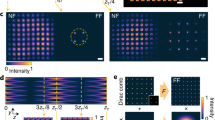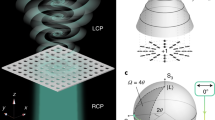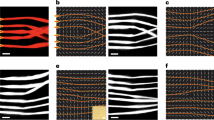Abstract
Optical vortices are beams of light that carry orbital angular momentum1, which represents an extra degree of freedom that can be generated and manipulated for photonic applications2,3,4,5,6,7,8. Unlike vortices in other physical entities, the generation of optical vortices requires structural singularities9,10,11,12, but this affects their quasiparticle nature and hampers the possibility of altering their dynamics or making them interacting13,14,15,16,17. Here we report a platform that allows the spontaneous generation and active manipulation of an optical vortex–antivortex pair using an external field. An aluminium/silicon dioxide/nickel/silicon dioxide multilayer structure realizes a gradient-thickness optical cavity, where the magneto-optic effects of the nickel layer affect the transition between a trivial and a non-trivial topological phase. Rather than a structural singularity, the vortex–antivortex pairs present in the light reflected by our device are generated through mathematical singularities in the generalized parameter space of the top and bottom silicon dioxide layers, which can be mapped onto real space and exhibit polarization-dependent and topology-dependent dynamics driven by external magnetic fields. We expect that the field-induced engineering of optical vortices that we report will facilitate the study of topological photonic interactions and inspire further efforts to bestow quasiparticle-like properties to various topological photonic textures such as toroidal vortices, polarization and vortex knots, and optical skyrmions.
This is a preview of subscription content, access via your institution
Access options
Access Nature and 54 other Nature Portfolio journals
Get Nature+, our best-value online-access subscription
$29.99 / 30 days
cancel any time
Subscribe to this journal
Receive 51 print issues and online access
$199.00 per year
only $3.90 per issue
Buy this article
- Purchase on Springer Link
- Instant access to full article PDF
Prices may be subject to local taxes which are calculated during checkout




Similar content being viewed by others
Data availability
The data that support the findings of this study are available from the corresponding authors upon reasonable request.
Code availability
All codes generated during this study are available upon request from the corresponding authors.
References
Coullet, P., Gil, L. & Rocca, F. Optical vortices. Opt. Commun. 73, 403–408 (1989).
Bliokh, K. Y., Rodríguez-Fortuño, F. J., Nori, F. & Zayats, A. V. Spin–orbit interactions of light. Nat. Photon. 9, 796–808 (2015).
Grier, D. G. A revolution in optical manipulation. Nature 424, 810–816 (2003).
Padgett, M. & Bowman, R. Tweezers with a twist. Nat. Photon. 5, 343–348 (2011).
Schmiegelow, C. T. et al. Transfer of optical orbital angular momentum to a bound electron. Nat. Commun. 7, 12998 (2016).
Bozinovic, N. et al. Terabit-scale orbital angular momentum mode division multiplexing in fibers. Science 340, 1545–1548 (2013).
Nicolas, A. et al. A quantum memory for orbital angular momentum photonic qubits. Nat. Photon. 8, 234–238 (2014).
Weber, M. et al. MINSTED fluorescence localization and nanoscopy. Nat. Photon. 15, 361–366 (2021).
Beijersbergen, M. W. Helical-wavefront laser beams produced with a spiral phaseplate. Opt. Commun. 112, 321–327 (1994).
Yu, N. et al. Light propagation with phase discontinuities: generalized laws of reflection and refraction. Science 334, 333–337 (2011).
Chong, K. E. et al. Polarization-independent silicon metadevices for efficient optical wavefront control. Nano Lett. 15, 5369–5374 (2015).
Deng, Z.-L. et al. Observation of localized magnetic plasmon skyrmions. Nat. Commun. 13, 8 (2022).
Uhlíř, V. et al. Dynamic switching of the spin circulation in tapered magnetic nanodisks. Nat. Nanotechnol. 8, 341–346 (2013).
Jenkins, A. S. et al. Spin-torque resonant expulsion of the vortex core for an efficient radiofrequency detection scheme. Nat. Nanotechnol. 11, 360–364 (2016).
Kwon, W. J. et al. Sound emission and annihilations in a programmable quantum vortex collider. Nature 600, 64–69 (2021).
Veshchunov, I. S. et al. Optical manipulation of single flux quanta. Nat. Commun. 7, 12801 (2016).
Dobrovoloskiy, O. V. et al. Ultra-fast vortex motion in a direct-write Nb-C superconductor. Nat. Commun. 11, 3291 (2020).
Mermin, N. D. The topological theory of defects in ordered media. Rev. Mod. Phys. 51, 591 (1979).
Blatter, G. et al. Vortices in high-temperature superconductors. Rev. Mod. Phys. 66, 1125 (1994).
Shinjo, T. et al. Magnetic vortex core observation in circular dots of permalloy. Science 289, 930–932 (2000).
Chmiel, F. P. et al. Observation of magnetic vortex pairs at room temperature in a planar α-Fe2O3/Co heterostructure. Nat. Mater. 17, 581–585 (2018).
Lagoudakis, K. G. et al. Quantized vortices in an exciton-polariton condensate. Nat. Phys. 4, 706–710 (2008).
Ma, X. et al. Realization of all-optical vortex switching in exciton-polariton condensates. Nat. Commun. 11, 897 (2020).
Indenbom, M. V. et al. Magneto-optical observation of twisted vortices in type-II superconductors. Nature 385, 702–705 (1997).
Reimann, T. et al. Visualizing the morphology of vortex lattice domains in a bulk type-II superconductor. Nat. Commun. 6, 8813 (2015).
Kosterlitz, J. M. & Thouless, D. J. Ordering, metastability and phase transitions in two-dimensional systems. J. Phys. C 6, 1181 (1973).
Christodoulou, P. et al. Observation of first and second sound in a BKT superfluid. Nature 594, 191–194 (2021).
Allen, L. et al. Orbital angular momentum of light and the transformation of Laguerre–Gaussian laser modes. Phys. Rev. A 45, 8185 (1992).
Gorodetski, A. et al. Observation of the spin-based plasmonic effect in nanoscale structures. Phys. Rev. Lett. 101, 043903 (2008).
Jin, J. et al. Topologically enabled ultrahigh-Q guided resonances robust to out-of-plane scattering. Nature 574, 501–504 (2019).
Wang, B. et al. Generating optical vortex beams by momentum-space polarization vortices centred at bound states in the continuum. Nat. Photon. 14, 623–628 (2020).
Situ, G. & Fleischer, J. W. Dynamics of the Berezinskii–Kosterlitz–Thouless transition in a photon fluid. Nat. Photon. 14, 517–522 (2020).
Bruno, P., Dugaev, V. K. & Tailefumier, M. Topological Hall effect and Berry phase in magnetic nanostructures. Phys. Rev. Lett. 93, 096806 (2004).
Jiang, W. et al. Direct observation of the skyrmion Hall effect. Nat. Phys. 13, 162–169 (2017).
Heinze, S. et al. Spontaneous atomic-scale magnetic skyrmion lattice in two dimensions. Nat. Phys. 7, 713–718 (2011).
Zheng, G. et al. Tailoring Dzyaloshinskii–Moriya interaction in a transition metal dichalcogenide by dual-intercalation. Nat. Commun. 12, 3639 (2021).
Xu, S.-Y. et al. Topological phase transition and texture inversion in a tunable topological insulator. Science 332, 560–564 (2011).
Sie, E. J. et al. An ultrafast symmetry switch in a Weyl semimetal. Nature 565, 61–66 (2019).
Carcia, P. F. Perpendicular magnetic anisotropy in Pd/Co and Pt/Co thin-film layered structures. J. Appl. Phys. 63, 5066 (1988).
Kim, D. et al. Extreme anti-reflection enhanced magneto-optic Kerr effect microscopy. Nat. Commun. 11, 5937 (2020).
Huang, B. et al. Layer-dependent ferromagnetism in a van der Waals crystal down to the monolayer limit. Nature 546, 270–273 (2017).
Hu, Y. et al. On-chip electro-optic frequency shifters and beam splitters. Nature 599, 587–593 (2021).
Kita, D. M. et al. High-performance and scalable on-chip digital Fourier transform spectroscopy. Nat. Commun. 9, 4405 (2018).
Lopez-Sanchez, O. et al. Ultrasensitive photodetectors based on monolayer MoS2. Nat. Nanotechnol. 8, 497–501 (2013).
Yu, Y. et al. Giant gating tunability of optical refractive index in transition metal dichalcogenide monolayers. Nano Lett. 17, 3613–3618 (2017).
Sroor, H. et al. High-purity orbital angular momentum states from a visible metasurface laser. Nat. Photon. 14, 498–503 (2020).
Bahari, B. et al. Photonic quantum Hall effect and multiplexed light sources of large orbital angular momenta. Nat. Phys. 17, 700–703 (2021).
Zdagkas, A. et al. Observation of toroidal pulses of light. Nat. Photon. 16, 523–528 (2022).
Shen, Y., Hou, Y., Papasimakis, N. & Zheludev, N. I. Supertoroidal light pulses as electromagnetic skyrmions propagating in free space. Nat. Commun. 12, 5891 (2021).
Larocque, H. et al. Reconstructing the topology of optical polarization knots. Nat. Phys. 14, 1079–1082 (2018).
Dennis, M. R. et al. Isolated optical vortex knots. Nat. Phys. 6, 118–121 (2010).
Wang, K., Dutt, A., Wojcik, C. C. & Fan, S. Topological complex-energy braiding of non-Hermitian bands. Nature 598, 59–64 (2021).
Acknowledgements
We thank S. Lee, D. Kim, S. Park and H. Oh for discussions. M.-K.S. acknowledges the support of the KAIST Cross-Generation Collaborative Lab project and the National Research Foundation of Korea (NRF) (2020R1A2C2014685 and 2020R1A4A2002828). J.S. acknowledges the support of the NRF (2021R1A2C200868711). D.K. acknowledges the support of the NRF (2015H1A2A1033753 and 2019R1A6A1A10073887). Y.-S.C. acknowledges the support of the NRF (2020R1I1A1A01069219).
Author information
Authors and Affiliations
Contributions
D.K. conceived the idea. A.B. and D.K. designed and fabricated the gradient-thickness optical cavity samples. D.K. and Y.-S.C. built the magneto-optic off-axis holography set-up. D.K. performed the magneto-optic measurements and the theoretical calculations. D.K. and M.-K.S. analysed the data and wrote the manuscript with input from all other authors.
Corresponding authors
Ethics declarations
Competing interests
The authors declare no competing interests.
Peer review
Peer review information
Nature thanks Haoran Ren, Lei Shi and the other, anonymous, reviewer(s) for their contribution to the peer review of this work. Peer reviewer reports are available.
Additional information
Publisher’s note Springer Nature remains neutral with regard to jurisdictional claims in published maps and institutional affiliations.
Extended data figures and tables
Extended Data Fig. 1 Amplitude and phase distribution of the calculated reflection coefficient components (r1 and r2) in the generalized parameter space (h1, h2).
a,b, Plot of the (a) amplitude and (b) phase of the reflection coefficient components r1 (the red curved surface) and r2 (the blue curved surface) near the reflection minima in the generalized parameter space for the GTOCs with hNi = 5, 10, and 15 nm. (Δh1, Δh2) represents the position away from the target reflection minimum in the generalized parameter space. The yellow and green solid curves represent the same amplitude (|r1| = |r2|) and out-of-phase conditions (arg(r1) = arg(−r2)), respectively. c, Projection of the same amplitude (the yellow curve) and out-of-phase (the green curve) conditions onto the generalized parameter space. The singular minimum of reflection for the non-trivial topological textures exists only when the two conditions intersect. The red and blue dots indicate the intersections for the optical vortex (w = +1) and antivortex (w = −1), respectively. The white circles indicate the positions of the weak reflection minima of the trivial topological phase (w = 0).
Extended Data Fig. 2 Polarization dependency of magneto-optically-driven optical vortex dynamics.
a,b, External magnetic-field-dependent behaviour of the complex reflection coefficient of the (a) optical vortex (Sample #2, w = +1) and (b) antivortex (Sample #3, w = −1) for the opposite handedness of the circular polarization (+σ and −σ) of the incident light.
Supplementary information
Supplementary Information
This file contains Supplementary Sections 1–13, including Supplementary Figs. 1–17 and References.
Supplementary Video 1
Plot of the same amplitude (the yellow curve) and out-of-phase (the green curve) conditions inside the GTOC unit cell (p × p) in the generalized parameter space depending on the thickness of the Ni layer. The red and blue dots indicate the intersections for the optical vortex (w = +1) and antivortex (w = −1), respectively.
Rights and permissions
Springer Nature or its licensor holds exclusive rights to this article under a publishing agreement with the author(s) or other rightsholder(s); author self-archiving of the accepted manuscript version of this article is solely governed by the terms of such publishing agreement and applicable law.
About this article
Cite this article
Kim, D., Baucour, A., Choi, YS. et al. Spontaneous generation and active manipulation of real-space optical vortices. Nature 611, 48–54 (2022). https://doi.org/10.1038/s41586-022-05229-4
Received:
Accepted:
Published:
Issue Date:
DOI: https://doi.org/10.1038/s41586-022-05229-4
This article is cited by
-
Orbital angular momentum-mediated machine learning for high-accuracy mode-feature encoding
Light: Science & Applications (2024)
-
Topologically crafted spatiotemporal vortices in acoustics
Nature Communications (2023)
-
Topological bound state in the continuum induced unidirectional acoustic perfect absorption
Science China Physics, Mechanics & Astronomy (2023)
Comments
By submitting a comment you agree to abide by our Terms and Community Guidelines. If you find something abusive or that does not comply with our terms or guidelines please flag it as inappropriate.



